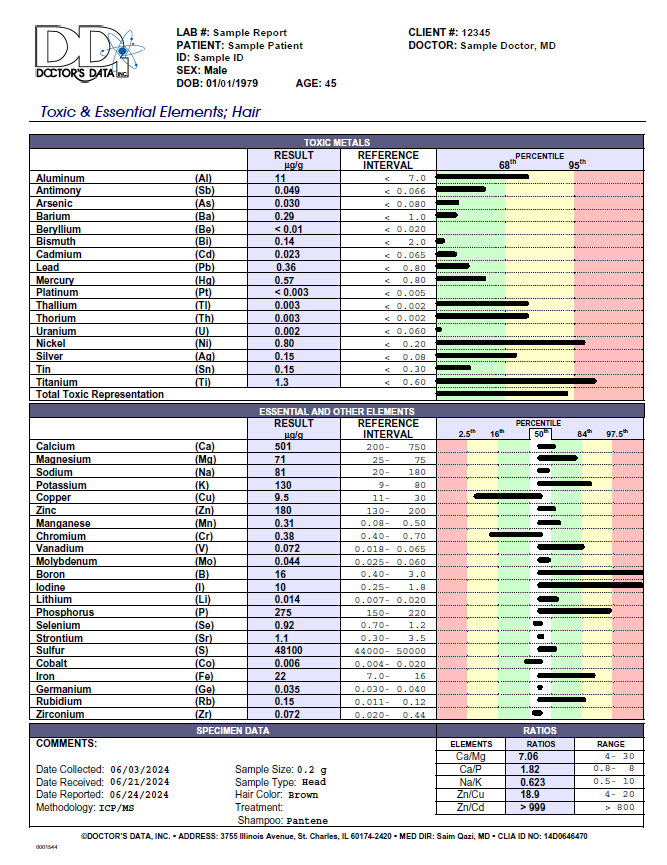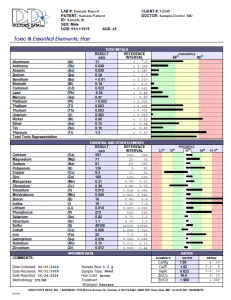Home / Shop
Doctors Data Hair Elements Test










- Description
- Specifications
- Customer Reviews (0)
Toxic and Essential Elements Hair Test
Your body can function to heal itself at the cellular level when nutrient deficiencies are corrected and toxic elements are eliminated with the right diet and environment. The Doctors Data Hair Elements Test for Minerals and Common Toxic Elements can determine your nutritional status as well as your body load of common heavy metals. A build up of toxic elements in the body can compromise your mineral status, affecting the health of your gut/mind/body and immune system function. Nutritional minerals such as Calcium, Magnesium, Sodium, Potassium, Copper, Zinc, Boron, Iron, Chromium and toxic elements such as lead, arsenic, mercury and uranium as well as many other minerals and toxic elements can be measured with a simple hair sample supplying the information required for important mineral relationships.
Features
- Doctor’s order not required
- No lab visit or office visit required
- Free Shipping within US
- Small hair sample collection
- 22 Essential Elements Reported
- 17 Toxic Elements Reported
- Results emailed to you
- Quick Results
Useful for:
- Toxic Element Exposure
- Excessive Fish Consumption
- Alopecia
- Depression
- Fatigue
- Malabsorption
- Hypertension
- Impaired Glucose Tolerance
- Kidney Function
- Parkinson's-like Symptoms
- Sexual Impotence or Decreased Testosterone Production
- Vision Problems
For a comprehensive test that reports only toxic elements, see our Doctors Data Hair Toxic Elements Test.
WHY TEST HAIR?
Extensive research has established that scalp hair element levels are related to body element levels. Many researchers consider hair as the tissue of choice for toxic and several nutrient elements. There are serious health problems associated with elevated toxic elements such as Arsenic, Lead, Aluminum, Barium, Cadmium, Gadolinium, Mercury, Nickel, Thallium, Uranium and others. Nutrition information including elements such as magnesium, chromium, zinc, copper and selenium are obligatory co-factors for hundreds of important enzymes and also are essential for the normal functions of vitamins. The levels of these elements in hair are correlated with levels in organs and other tissues.
Hair element analysis provides important information. As protein is synthesized in the hair follicle, elements are incorporated permanently into the hair. And, toxic elements may be 200-300 times more highly concentrated in hair than in blood or urine. Therefore, hair is the tissue of choice for detection of recent exposure to toxic elements such as arsenic, aluminum, cadmium, lead, antimony, and mercury.
Unlike blood, hair toxic and mineral element levels are not regulated by homeostatic mechanisms. Thus, changes in hair element levels often appear prior to overt symptoms and can thereby be a valuable preliminary tool for predicting the development of abnormalities leading to disease states.
Hair, however, is vulnerable to external elemental contamination by means of certain shampoos, bleaches, dyes, air pollution, and curing or straightening treatments. Therefore, the first step in the interpretation of a hair element report is to rule out sources of external contamination.
Hair toxic element analysis is a valuable and inexpensive screen for body burden of toxic heavy metals that you may have been exposed to in the past. For example, toxins can be acquired from food, skin exposure and air pollution. A hair collection kit is sent to you with instructions, signed doctor’s order and return shipping prepaid. An extensive report will be sent to you by email in about a week.
NOTE: Your Doctors Data Hair Elements Test report will be sent to the email used when ordering, unless otherwise specified. If you have further questions after receiving your report, a Telehealth Appointment with Dr. Ray Psonak can be scheduled for an additional fee.
FAQ's about At Home Health Tests
Analytes Tested
Antimony, Arsenic, Barium, Beryllium, Bismuth, Boron, Cadmium, Calcium, Chromium, Cobalt, Copper, Germanium, Iodine, Iron, Lead, Lithium, Magnesium, Manganese, Mercury, Molybdenum, Nickel, Phosphorus, Platinum, Potassium, Rubidium, Selenium, Silver, Sodium, Strontium, Sulfur, Thallium, Thorium, Tin, Titanium, Uranium, Vanadium, Zinc, Zirconium
Detailed Information
A specialist and pioneer in essential and toxic elemental testing since 1972, Doctor's Data has been validated as a supplier of trace element results for the certification of a hair reference material to the European Commission Joint Research Centre.
With respect to its contained elements, hair is essentially an excretory tissue rather than a functional tissue. Hair element analysis provides important information which, in conjunction with symptoms and other laboratory values, can assist the physician with an early diagnosis of physiological disorders associated with aberrations in essential and toxic element metabolism.
As protein is synthesized in the hair follicle, elements are incorporated permanently into the hair with no further exchange or equilibration with other tissues. Scalp hair is easy to sample, and because it grows an average of one to two cm per month, it contains a "temporal record" of element metabolism and exposure to toxic elements.
Nutrient elements including magnesium, chromium, zinc, copper and selenium are obligatory co-factors for hundreds of important enzymes and also are essential for the normal functions of vitamins. The levels of these elements in hair are correlated with levels in organs and other tissues.
Toxic elements may be 200 to 300 times more highly concentrated in hair than in blood or urine. Therefore, hair is the tissue of choice for detection of recent exposure to elements such as arsenic, aluminum, cadmium, lead, antimony and mercury. The CDC acknowledges the value of hair mercury levels as a maternal and infant marker for exposure to neurotoxic methylmercury from fish.
Through recent vast improvements in technology, instrumentation and application of scientific protocols, hair element analysis has become a valuable tool for providing dependable and useful data for physicians and their patients. The U.S. Environmental Protection Agency stated in a recent report that "...if hair samples are properly collected and cleaned, and analyzed by the best analytic methods, using standards and blanks as required, in a clean and reliable laboratory by experienced personnel, the data are reliable." (U.S.E.P.A. 600/4-79-049)
Hair, however, is vulnerable to external elemental contamination by means of certain shampoos, bleaches, dyes, and curing or straightening treatments. Therefore, the first step in the interpretation of a hair element report is to rule out sources of external contamination.
Hair element analysis is a valuable and inexpensive screen for physiological excess, deficiency or maldistribution of elements. It should not be considered a stand-alone diagnostic test for essential element function, and should be used in conjunction with patient symptoms and other laboratory tests. Doctor's Data offers a Hair Toxic and Essential Elements profile and a Hair Toxic Element Exposure profile containing an expanded lineup of toxic metals.

